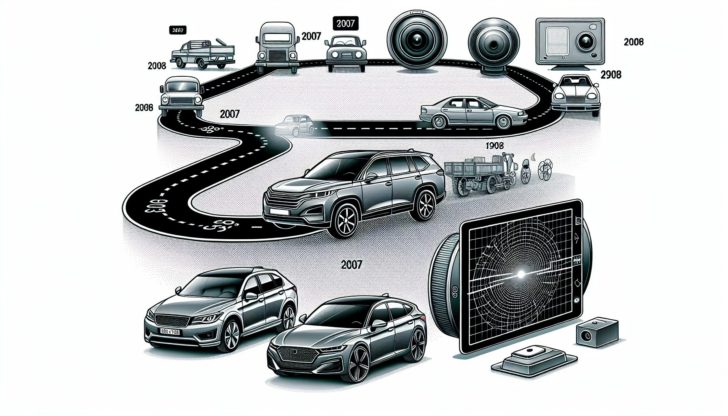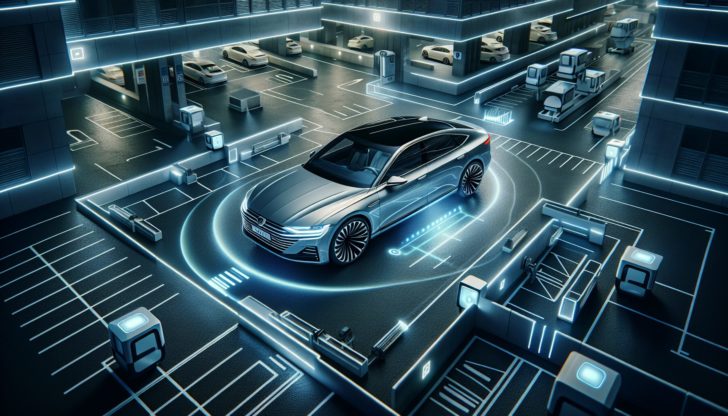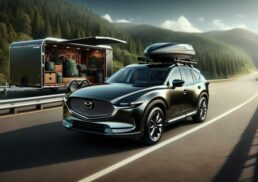Looking for a car with 360 camera? Our guide spotlights top 2024 models that boost your driving safety with bird’s-eye views. Discover vehicles that blend this smart tech with comfort and convenience, and see how it transforms your driving—with no fluff or sales talk.
Table of Contents
Key Takeaways
360-degree camera systems have evolved from rare luxuries to widely available safety features in many mainstream car models, making driving and parking much safer and easier.
The integration of camera systems with vehicle controls, like steering wheels, is improving the driver experience by allowing for seamless operation without taking hands off the wheel.
Combining 360-degree visibility with all-wheel drive and hybrid powertrains, modern vehicles offer a blend of safety, sustainability, and performance, becoming standard even in non-luxury segments.
The Evolution of the 360-Degree Camera in Modern Vehicles

Cast your mind back to 2007, when Nissan introduced the world to their Around View Monitor system, a groundbreaking evolution in vehicular safety technology. Before this innovation, drivers relied on single rear-view cameras and ultrasonic sensors, which paled in comparison with the panoramic prowess of surround view cameras. These modern marvels employ four wide-angle cameras that synthesize a bird’s-eye view of the vehicle’s surroundings, revolutionizing the way we perceive the space around our cars.
Following Nissan’s lead, automakers like Mitsubishi and Honda quickly jumped on the bandwagon, integrating similar systems, including pedestrian detection, into their models. Nissan itself continued to refine their technology, adding moving object detection to create the Intelligent Around View Monitor, further enhancing driver awareness and safety. As we look to the horizon, we can anticipate even more spectacular advancements, such as 3D renderings, to further elevate our spatial awareness.
Navigating Tight Spaces: Cars with Superior Parking Assistance

Have you ever found yourself sweatily grappling with the steering wheel, attempting a tight parallel park? Well, cars like the Nissan with their Intelligent Around View Monitor system have turned this nerve-wracking experience into a smooth operation. But it’s not just Nissan in this space; the Mercedes-Benz E-Class and CLE have upped the ante with automatic features for both parallel and perpendicular parking, making city driving a breeze. In fact, the precision of these systems is so remarkable that a stuntman used the Nissan Juke’s version to nail a record-matching tight J-turn in a space barely wider than the car itself.
Beyond mere parking prowess, vehicles like the E-Class don’t stop at parking utility; they’re packed with additional features like hands-free trunks and in-car WiFi – a veritable Swiss Army knife of tech features for the urban driver, including the parking assistance package.
The Role of Side View Cameras
When it comes to 360-degree camera systems, side view cameras are the unsung heroes. They’re the crucial pieces that expand our visual coverage, ensuring that every inch around the car is accounted for. During those heart-pounding moments of parking, they provide a clear view of the curb and any lurking obstacles, guiding us smoothly into the tightest of spots.
In the dance of parallel parking, it’s the side view cameras that lead, providing an overhead perspective to make the process easier. They are the ones that give us a bird’s eye view where we previously had to rely on mirrors and guesswork, turning a potentially hazardous maneuver into a precise and controlled move. With only a handful of these cameras, the task becomes significantly simpler.
Integration with Steering Wheel Controls
The future of driving isn’t just about seeing more; it’s about seamless interaction with our vehicles. Integration kits, like the CTKNS19 for the Nissan X-Trail, exemplify this beautifully by bridging the gap between aftermarket head units and the vehicle’s original 360-degree camera functionality, all through the convenience of steering wheel controls. It’s not just about the tech; it’s about the aesthetics and functionality, with features like a custom fascia panel that blends with the car’s design and time-setting capabilities via the steering wheel.
Imagine steering through the roads, your hands never leaving the wheel, as you shift views and toggle through camera angles with intuitive ease. This integration is the epitome of modern driving – where control, comfort, and safety are literally at your fingertips.
Premium Features Without the Premium Price Tag
In the past, a surround view camera system was a luxury reserved for the high-end models gleaming in the showroom. Fast forward to today, and we’re living in a golden era where premium features like 360-degree four cameras are becoming standard fare in the offerings from mainstream manufacturers such as:
Nissan
Mazda
Hyundai
Toyota
Mitsubishi
Take, for instance, the Nissan Rogue SV, which can be equipped with this high-tech system within its premium package.
But what’s even more exciting is that this technology is becoming more accessible than ever. With camera kits ranging from $200 to $900 and vehicles equipped with these systems priced around the $37,000 mark, it’s a small price to pay for the vast improvement in safety and convenience. Models like the Hyundai Santa Fe Limited trim and the Chevrolet Equinox with the Confidence & Convenience II package are perfect examples of how you can enjoy these premium features without the high cost.
All-Wheel Drive Meets 360-Degree Visibility
The marriage of all-wheel drive and 360-degree visibility is like peanut butter and jelly – they’re just better together. Take the 2024 Toyota Land Cruiser, for example, a beast on the off-road terrain with a standard locking rear differential and a suite of modern tech features, including a 360-degree camera system. Similarly, the 2024 Lexus GX doesn’t hold back in offering luxury alongside its robust off-road capabilities, all the while ensuring you have a clear view of the obstacles that lie ahead.
And it’s not just about power and luxury; it’s about being responsible on the road and considering the environment. The 2024 Land Cruiser, for example, is available with a four-cylinder hybrid powertrain, combining fuel efficiency with its off-road prowess – all at a starting price that won’t break the bank. This blend of features ensures that you can confidently navigate any terrain with the added assurance of 360-degree surveillance.
Compact SUVs with Bird’s Eye Views
Compact SUVs may be smaller in size, but they’re big on innovation, especially when it comes to driver visibility. The Hyundai Tucson leads the pack by offering a surround view camera system as a standard feature, not an expensive extra. Nissan isn’t far behind with the Rogue Sport, where a bird’s eye view is available within an optional package for those who value an extra pair of virtual eyes on the road.
Mazda, a pioneer in the compact SUV segment, introduced the 360-degree camera system in the CX-5, marking a shift towards more comprehensive driver visibility. The CX-5 Signature trim goes a step further, combining this high-tech system with luxury touches like Nappa leather upholstery and real wood trim, proving that compact doesn’t have to mean compromising on quality and technology.
Top Sedans with Panoramic Camera Systems
The realm of sedans is witnessing a technological renaissance, with panoramic camera systems becoming a coveted feature for the urban driver. The BMW 5 Series, synonymous with luxury and performance, is now also known for its 360-degree camera that works in concert with front and rear parking sensors and a lane keep assist system, providing a cocoon of safety for its passengers. Meanwhile, the 2024 Mercedes CLE brings a touch of the outdoors inside with its panoramic moonroof, adding to its suite of impressive technological aids.
Even the steadfast Toyota Camry, a household name in reliability, has joined the ranks. The Camry XLE, with its Navigation Upgrade Package, offers customers the option of adding a panoramic view monitor, thus democratizing access to this advanced technology. It’s a testament to how these systems are no longer niche; they’re becoming the new norm for sedans across the market.
Entry-Level Luxury with High-Tech Surroundings
Dipping your toes into the luxury vehicle market no longer requires a plunge into the deep end of the price pool. Vehicles like the 2024 Lexus GX are redefining what it means to be entry-level, by including a 360-degree camera as standard equipment. And it doesn’t stop there; the Lexus GX also boasts a powerful twin-turbo V6 engine and a suite of advanced infotainment and safety technologies.
The Mitsubishi Outlander SEL is another shining example of the best cars, offering standard features such as a surround view camera system, making high-tech safety features more accessible than ever before. Even the Mercedes CLE doesn’t shy away from packing its entry-level models with high-tech features, ensuring that even at the starting line, drivers are surrounded by convenience and safety.
This surge of technology in entry-level luxury new cars is a clear indicator that manufacturers are committed to providing a premium driving experience across their lineups, without the high cost typically associated with luxury models.
Hybrid Power and 360-Degree Surveillance
As we turn our attention to the environment, hybrid vehicles are stepping up, not just with their eco-friendly powertrains, but also with advanced surveillance technology. The 2025 Mazda CX-70 is at the forefront of this movement, offering a mild hybrid system and a plug-in hybrid option, ensuring that drivers can enjoy the benefits of electrification without sacrificing 360-degree visibility. The Lexus TX hybrid extends this commitment to choice and innovation, providing a range of powertrain options including a traditional hybrid and a plug-in hybrid, catering to the various preferences of eco-conscious consumers.
This integration of hybrid power and cutting-edge camera technology is a clear signal of the automotive industry’s dedication to offering a well-rounded driving experience that doesn’t just look out for the driver’s safety, but also for the well-being of the planet. It’s a harmonious blend of power, safety, and sustainability that is quickly becoming the standard for the vehicles of the future.
Tailored Technology: Automakers That Customize Camera Systems
In the pursuit of delivering the ultimate driving experience, automakers are going beyond one-size-fits-all solutions. They’re crafting tailored technology that addresses the unique needs of their diverse vehicle lineups. Nissan, for example, has demonstrated its ability to integrate camera systems from previous generations into new aftermarket head units, preserving the factory-installed 360-degree cameras that many drivers have come to rely on. Honda’s 2024 Prologue SUV is another testament to the power of collaboration, merging General Motors’ technology with Honda’s design ethos to create a vehicle that stands out in both form and function.
But this customization doesn’t come without its challenges. Installing a 360-degree camera system with the precision it requires could incur additional costs, especially when seeking professional assistance. Yet, despite these hurdles, mainstream brands like Toyota, Nissan, and Mitsubishi are steadfast in their efforts to offer tailored camera systems that enhance driver awareness and safety. It’s a commitment that underscores the importance of technology in modern vehicles and the lengths automakers will go to ensure that each model is equipped with the best systems to suit its purpose.
The Future of Vehicle Monitoring: Innovations in Camera System Tech
Peering into the crystal ball of vehicle technology, we see a future where our cars don’t just react to the world around them; they predict it. The integration of artificial intelligence into vehicle monitoring systems promises real-time analysis of both driver behavior and environmental conditions, setting the stage for a revolution in safety and efficiency. The combination of AI, telematics, and the Internet of Things is poised to deliver a more complete perspective on vehicle operations, empowering smarter decision-making.
With machine learning algorithms and the advent of 5G networks, the capabilities of camera systems are set to skyrocket, offering faster and more accurate predictive analytics. As these technologies advance, the automotive industry must navigate the complexities of data privacy, security, and the cost of system implementation, ensuring that these innovations remain accessible and secure for all drivers.
Check out 20 Best Cars with Around View Camera for 2024 – Ranked.
Summary
As we’ve journeyed through the landscape of 360-degree camera technology in cars, we’ve seen how it has evolved from a luxury feature to a standard offering across various segments. From maneuvering tight parking spots with ease to traversing rugged off-road terrain with confidence, the integration of this technology has redefined safety and convenience. As we look ahead, the fusion of AI, machine learning, and 5G connectivity promises to take vehicle monitoring to new heights. Let’s embrace this era of smarter, safer driving with open arms and clear views.
Frequently Asked Questions
Are 360-degree camera systems available in all types of vehicles?
Yes, 360-degree camera systems are now available in a variety of vehicle types, including compact SUVs, sedans, and even entry-level luxury cars. So, they are not limited to premium and luxury models anymore.
Can I retrofit a 360-degree camera system into an older vehicle?
Yes, it’s possible to retrofit a 360-degree camera system into an older vehicle by purchasing an aftermarket kit, but installation will require precise calibration and may involve additional costs if professional assistance is needed.
Does the presence of a 360-degree camera system impact insurance costs?
Yes, having a 360-degree camera system can potentially lower your insurance premiums, but it depends on the insurer and your specific policy. It’s worth checking with your insurance provider to see if they offer any discounts for this feature.
Are there any privacy concerns with using 360-degree camera systems in vehicles?
Yes, privacy and data security are important considerations when using 360-degree camera systems in vehicles. Manufacturers are actively working to address these concerns.
Will 360-degree camera systems in vehicles become more advanced in the future?
Yes, as technology continues to advance, 360-degree camera systems in vehicles are expected to become more advanced, incorporating artificial intelligence, machine learning, and 5G networks for improved functionality and predictive capabilities.









